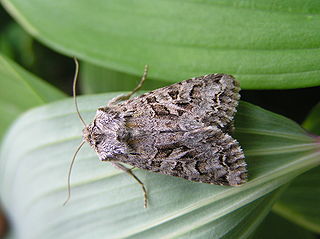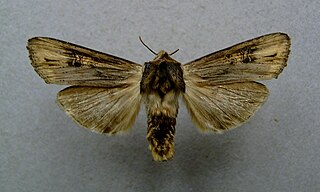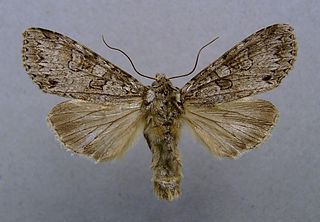| Octasphales niphadosticha | |
|---|---|
| Scientific classification | |
| Kingdom: | Animalia |
| Phylum: | Arthropoda |
| Class: | Insecta |
| Order: | Lepidoptera |
| Family: | Depressariidae |
| Genus: | Octasphales |
| Species: | O. niphadosticha |
| Binomial name | |
| Octasphales niphadosticha Meyrick, 1930 | |
Octasphales niphadosticha is a moth in the Depressariidae family. It was described by Edward Meyrick in 1930. It is found in New Guinea. [1]

Moths comprise a group of insects related to butterflies, belonging to the order Lepidoptera. Most lepidopterans are moths, and there are thought to be approximately 160,000 species of moth, many of which have yet to be described. Most species of moth are nocturnal, but there are also crepuscular and diurnal species.

Depressariidae is a family of moths. It has formerly been treated as a subfamily of Gelechiidae, but is now recognised as a separate family, comprising about 2300 species worldwide.
Edward Meyrick FRS was an English schoolmaster and amateur entomologist. He was an expert on Microlepidoptera and some consider him one of the founders of modern Microlepidoptera systematics.
The wingspan is about 17 mm. The forewings are grey, darker on the veins, strewn throughout with numerous white dots forming a longitudinal series, posteriorly on the veins. The costal edge is white between the antemedian scale-projection and the cilia. The hindwings are grey. [2]

The wingspan of a bird or an airplane is the distance from one wingtip to the other wingtip. For example, the Boeing 777-200 has a wingspan of 60.93 metres, and a wandering albatross caught in 1965 had a wingspan of 3.63 metres, the official record for a living bird. The term wingspan, more technically extent, is also used for other winged animals such as pterosaurs, bats, insects, etc., and other fixed-wing aircraft such as ornithopters. In humans, the term wingspan also refers to the arm span, which is distance between the length from one end of an individual's arms to the other when raised parallel to the ground at shoulder height at a 90º angle. Former professional basketball player Manute Bol stands at 7 ft 7 in (2.31 m) and owns one of the largest wingspans at 8 ft 6 in (2.59 m).














